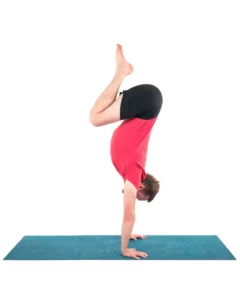Bolster Your Upward Facing Dog Pose

Article At A Glance
Upward Facing Dog Pose (Urdhva Mukha Svanasana) is a challenging backbending pose that is one of the components of yoga’s Sun Salutations (Surya Namaskar). Like other backbends, it counteracts the effects of sitting and can energize the body and mind. Practicing the pose with the support of yoga blocks and a bolster can help you refine your pose to help keep your low back in a healthy alignment.
Upward Facing Dog Pose (Urdhva Mukha Svanasana) is one of the key elements in Sun Salutations (Surya Namaskara). It’s often paired with its littermate Downward Facing Dog Pose (Adho Mukha Svanasana), but it’s a worthy pose in its own right. Downward-Facing Dog Pose may be the better-known of the two, but we’ll let its less-famous sibling have its day in this post. 
Upward Facing Dog Pose provides many benefits. Here are a few:
- Strengthens shoulders, arms, hands and wrists
- Counteracts the effects of too much sitting and bending forward
- Can relieve lower back pain
- Energizes the body and mind
Challenges and Solutions for Practicing Upward Facing Dog Pose
Urdhva Mukha Svanasana is a challenging pose. It strengthens the shoulders, arms, hands, and wrists because it challenges them. There’s a tendency to collapse into the shoulders, hands, and wrists in the pose. To avoid relying too much on these structures, it’s important to engage the rest of the body in the pose as well. The whole body needs to contribute to the lift in the pose. A yoga bolster plus a couple of yoga blocks can be extremely helpful in shifting the work in the pose to the lower body. This relieves pressure on your hands and wrists. I’ll explain how to use these props in the instructions below.
The other physical challenge in Upward Facing Dog Pose is the tendency to stress the lower back. If you practice the pose with your head thrown back so that you’re looking at the sky, you are probably creating extra stress on your back. Keeping your head in a neutral position in this pose helps to support your lower back.
This is due to the positioning of a small bone at the top of the throat, the hyoid bone. Here’s a post that discusses head position in backbending poses.
Contraindications for Practicing Upward Facing Dog Pose
Before we dive into practicing the pose, I’d like to share some situations in which it might be best to avoid practicing Urdhva Mukha Svanasana:
- Injuries to your hands, wrists, shoulders, or low back
- Second and third trimesters of pregnancy
- Recent abdominal surgery
- If you have a headache, skip practicing this pose.
How to Practice Urdhva Mukha Svanasana with a Bolster

- Gather your props: a yoga mat, two yoga blocks, and a yoga bolster.
- Place your bolster crosswise on your mat about ⅔ of the way toward the “head” end of your mat. Place your blocks, shoulders-width apart, directly in front of your bolster in their lowest setting.
- Start in Downward Facing Dog Pose with your hands on your blocks. Placing your hands on blocks shifts your weight back into your feet a bit more than usual.
- Shift your whole body forward and lower your hips onto your bolster. The hip bones should be resting on the edge of the bolster.
- Engage your legs by isometrically lifting them up toward the ceiling. Press your feet down into the floor.
- Press down into your hands to lift the chest, keeping your elbows bent. Keep your head level, looking straight ahead.
- Take 5 to 10 deep breaths. Then shift back into Downward Facing Dog Pose with your hands on your blocks.
- When you’re ready, release your knees down onto the floor and rest in Child’s Pose (Balasana). You can rest your forearms and forehead on your bolster for extra comfort.
Also, read...
Teaching Svadhyaya: 3 Ways to Encourage Self-Study in Yoga
In Celebration of Gray-Haired Yoga – Busting the Myth of the Yoga Body
Related courses

Charlotte Bell began practicing yoga in 1982 and began teaching in 1986. She was certified by B.K.S. Iyengar in 1989 following a trip to Pune. In 1986, she began practicing Insight Meditation with her mentors Pujari and Abhilasha Keays. Her asana classes blend mindfulness with physical movement. Charlotte writes a column for Catalyst Magazine and serves as editor for Yoga U Online. She is the author of two books: Mindful Yoga, Mindful Life, and Yoga for Meditators, both published by Rodmell Press. She also edits Hugger Mugger Yoga Products’ blog and is a founding board member for GreenTREE Yoga, a non-profit that brings yoga to underserved populations. A lifelong musician, she plays oboe and English horn in the Salt Lake Symphony and the folk sextet Red Rock Rondo whose 2010 PBS music special won two Emmys.



